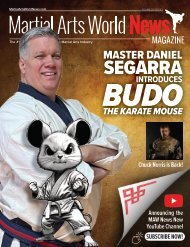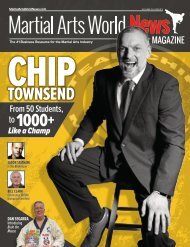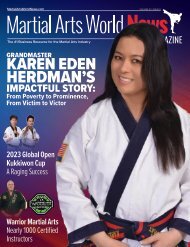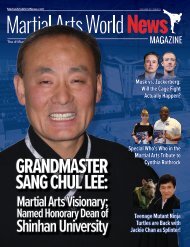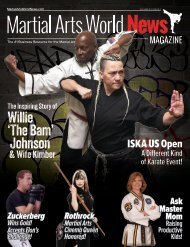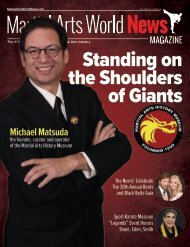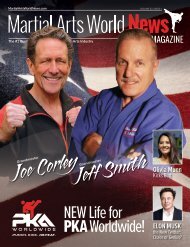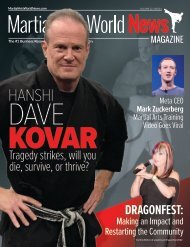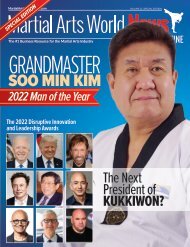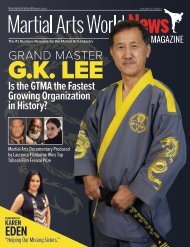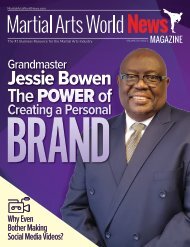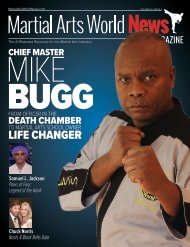Martial Arts World News Magazine - Volume 22 | Issue 2
The #1 Business Resource for the Martial Arts Industry
The #1 Business Resource for the Martial Arts Industry
Create successful ePaper yourself
Turn your PDF publications into a flip-book with our unique Google optimized e-Paper software.
BUDO PHILOSOPHY<br />
A Particular Vision, Part 1<br />
By Shidoshi Alfredo Tucci<br />
“<strong>Martial</strong> art is the art of the mobilization and correct use of vital energy.<br />
Its techniques, positions, dances, and fights produce deep<br />
stimulations in the energy meridians of the internal organs and<br />
chakras, awakening our deeper and most unconscious feelings<br />
and sensations. Through that vibrational resonance with the primary,<br />
the movement of martial art revives in us our capacity to live<br />
in the present moment, as well as forgotten behavioral mechanisms,<br />
so necessary and balancing, as it happens in the case of the<br />
inhibition of aggressiveness and screaming, while making it easier<br />
for us to make an instant and intuitive assessment of reality.” –José<br />
Luis Paniagua Tébar<br />
Much of my training in martial practices was with a very special<br />
teacher, a man ahead of his time and a full-fledged transgressor.<br />
Back in the ’80s, José Luis Paniagua Tébar had a courageous<br />
experience, which, as expected in any revolution, didn’t satisfy<br />
anyone except, of course, those of us who lived it and<br />
participated in it.<br />
“Traditionalists” from both Taekwondo and<br />
Karate often looked at him with squinty eyes,<br />
and psychotherapists, who sent many of their<br />
clients to his classes, observed him with resentment,<br />
and I would even say with some envy.<br />
His heterodoxy led him to include in his classes<br />
Yoga, Tai Chi, middle-distance running (13 km),<br />
and especially a type of physical training in which<br />
particular attention was paid to the movement<br />
of energy flows.<br />
You had to learn the Taekwondo Hyons<br />
and their techniques, and of course,<br />
the Shotokan Kata forms and their<br />
techniques. But, above all, Paniagua<br />
put great emphasis in certain points<br />
generally ignored by other persons<br />
and systems, considering martial arts<br />
as a whole original that had been<br />
broken down into differences of<br />
cultural nuances behind which prevailed<br />
a holistic sense, long before<br />
that term began to be used.<br />
A supporter of the correct inclusion of Yin and Yang techniques<br />
in their right order and sequence, he maintained that this<br />
specialization was a DENATURALIZATION of <strong>Martial</strong> Art, with<br />
capital letters, an inclusive idea which led to a personal and very<br />
well-structured syncretic vision of an activity, which for others was<br />
nothing more than a sport, combat system, or cultural practice. He<br />
described it for the first time in a book whose title says it all: “<strong>Martial</strong><br />
<strong>Arts</strong>: Body-Mind Balance.”<br />
The idea of seeing martial arts as a practice focused on this<br />
purpose was very encouraging for a young Alfredo Tucci, hungry<br />
for knowledge and willing to reach the very core of things. I<br />
wasn’t the only one. An interesting group of practitioners joined<br />
the classes, a heterodox group without a doubt because, except<br />
for a few exceptions, probably none of them would have ever<br />
thought of wearing a kimono, much less kicking and punching;<br />
renowned psychologists, noted characters from the art world,<br />
financial aristocracy, medicine doctors, engineers, sociologists,<br />
many college students, and some occasional “thrill seeker” as<br />
the present writer.<br />
The TEAM—acronym for Taller Experimental de Artes Marciales<br />
(<strong>Martial</strong> <strong>Arts</strong> Experimental Workshop), formerly TEPAM,<br />
Taller Experimental y Psicodinámico de Artes Marciales (Experimental<br />
and Psychodynamic <strong>Martial</strong> <strong>Arts</strong> Workshop, the P fell<br />
with the early departure of a group of psychotherapists)—was<br />
a spectacular experience. To start, it didn’t look like a gym. In<br />
the no. 45 Pirineos St. of Madrid, the leaves of the Dehesa de la<br />
Villa Park trees practically slipped through the windows, and the<br />
park, crossing a quiet street, became on Mondays our training<br />
place, where we jogged under pines in that beautiful and welllooked-after<br />
haven of peace surprisingly located in the center of<br />
the capital of Spain.<br />
Paniagua was a master in directing the group energy flows<br />
based on his idea of cycles of rupture, expansion, stillness. People<br />
came out refreshed from classes. Even today the idea of training<br />
combat for an hour and a half, and then finishing the class doing<br />
Yoga and meditation, is an absolute transgression.<br />
SHIDOSHI ALFREDO TUCCI is the CEO and General Manager of the Budo International Publishing<br />
Company, a leading publisher in the martial arts with over 35 years in the industry. He is also author of several<br />
books: The Immaterial Dimension, The Way of the Warrior, and The Spirit. He currently lives in Valencia, Spain.<br />
86 MARTIAL ARTS WORLD NEWS VOLUME <strong>22</strong> | ISSUE 2



